Shift-left security and CI/CD pipelines
Published | June 29, 2025 |
As your development teams move fast with CI/CD workflows, security has to move faster.
Shift-left security embeds cloud security controls directly into your CI/CD pipelines. With infrastructure as code (IaC) scanning, real-time remediation guidance and build-time container analysis, your team can find and fix misconfigurations earlier, without slowing development.
Expose key concepts
- Shift-left security and CI/CD pipeline integration in the cloud
- What is shift-left security?
- Why traditional security can’t keep up with CI/CD
- How shift-left improves development velocity and security
- CI/CD pipeline integration with IaC scanning
- Fix misconfigurations earlier with actionable pull request guidance
- Shift-left in container builds and cloud workload protection
- Developer productivity and security team alignment
- How shift-left supports compliance
- Shift-left security resources
- Shift-left security products
Shift-left security and CI/CD pipeline integration in the cloud
Traditional approaches that delay scanning until after deployment no longer cut it. Shift-left security addresses this challenge by moving cloud security checks earlier in development.
By analyzing infrastructure as code (IaC), permissions and container configurations before deployment, your teams can catch misconfigurations before they reach production environments.
What is shift-left security?
Shift-left security means integrating security tools and policies at the start of the development process.
Instead of testing after deployment or in production, you scan and fix issues directly within code repositories, IaC files and container builds.
This method aligns with DevSecOps practices and allows developers to address problems in the environment they’re already working in, while keeping velocity high and maturing security posture.
Why traditional security can’t keep up with CI/CD
In fast-paced environments with multiple daily deployments, delaying scans until staging or production leads to:
- Longer feedback loops
- Harder-to-fix vulnerabilities
- Security team bottlenecks
When developers push code rapidly, any process that slows deployment is a friction point. If security happens too late, risks go live unnoticed or require emergency hotfixes that introduce more risk.
How shift-left improves development velocity and security
Shift-left security enables your team to:
- Detect misconfigurations earlier
- Get feedback during the coding process
- Avoid rewrites or rollbacks after deployment
- Reduce vulnerability triage time
Security becomes part of the pull request (PR) review cycle instead of an obstacle after deployment. The result is better collaboration between security and engineering teams and a lower overall cloud risk profile.
CI/CD pipeline integration with IaC scanning
One of the most effective shift-left strategies is scanning IaC templates during development.
Tools like Tenable Cloud Security integrate with GitHub, GitLab and Bitbucket to scan Terraform, CloudFormation and Kubernetes YAML files for issues such as:
- Open security groups
- Publicly exposed S3 buckets or storage
- Overly permissive IAM roles
- Missing encryption settings
Integrating these scans into the CI/CD pipeline prevents misconfigurations from merging or deploying unless your teams fix them.
Fix misconfigurations earlier with actionable pull request guidance
When your cloud security platform flags a policy violation or vulnerability, it directly provides context-aware remediation guidance in the pull request.
Developers can review what is wrong, why it matters and how to fix it without leaving their workflow. They can commit, test and push the fix automatically through infrastructure as code pipelines. This closes the loop between finding a misconfiguration and deploying a secure update.
Shift-left in container builds and cloud workload protection
Shift-left doesn’t stop at IaC. Secure development also includes build-time container scanning. Your cloud security solution should integrate with image registries and build tools to:
- Detect vulnerabilities in base images and packages
- Identify risky libraries or misconfigurations
- Prevent insecure images from progressing to deployment
Paired with cloud workload protection (CWP), this ensures containers scanning before runtime and ensures continuous monitoring once in production.
Developer productivity and security team alignment
A key benefit of CI/CD pipeline integration is that it improves team alignment:
- Developers get fast, actionable security insights
- Security teams get early visibility into what’s shipping
- Neither team blocks the other
This model replaces ad-hoc reviews and late-stage blockers with consistent, code-native controls that scale.
How shift-left supports compliance
Embedding security controls earlier also supports audit readiness. Your cloud security solution should enforce policies aligned to standards like:
When the system flags violations in pull requests and you resolve them before merging, you gain evidence of preventive controls. This also reduces the risk of downstream findings during compliance reviews.
Ready to learn more about CI/CD pipeline integration? Shift-left with IAC security from Tenable.
Shift-left security resources
Shift-left security products
Cybersecurity news you can use
- Tenable Cloud Security
